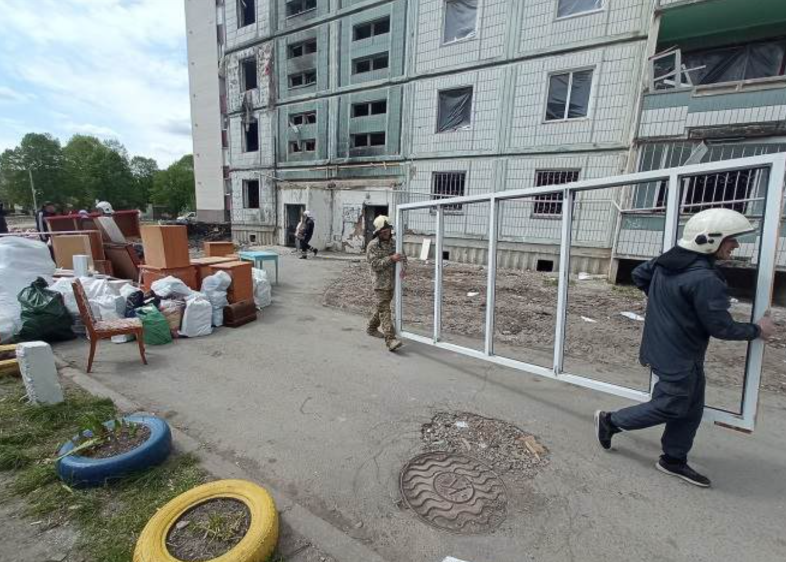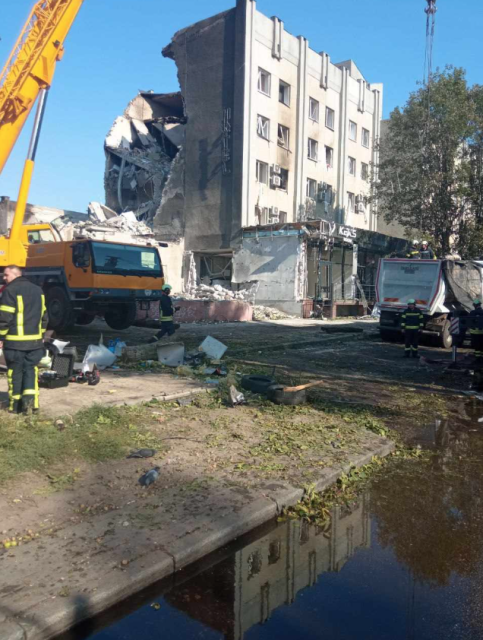“They were killed by Russia” – says an inscription on a cube with photographs of people who were killed by the Russian missile strike on a residential block in Uman. You can still smell explosions in the air. Some random person walks towards the portraits, prays, and crosses themselves. The portraits of the deceased are dated 28 April 2023. There is a list of 23 people whose lives were taken by the Russian missile that night. Both adults and children were among the victims. These peaceful citizens, who lived hundreds of kilometers away from the frontline, posed no threat to Russia. Yet, Russia took their lives. Those who survived are receiving aid from various foundations. Some have been accommodated by the local Hasidic hotels, while others were transferred to social housing.
GEM, a charitable foundation, replaced windows in Uman’s buildings affected by the Russian missile strikes. Overall they’ve replaced more than a thousand windows. This is targeted assistance from a global international organisation, which also provides water purification systems to residents of villages across Africa and had previously assisted the victims of the earthquake in Turkey.
Rebuilding Ukraine’s infrastructure is supposed to be carried out using Ukrainian state budget funds as well as donor support. One may also expect reparations, which Russia will eventually be ordered to pay. But when will that happen? After the Second World War Europe began rebuilding its cities approximately three years after the war ended. Ukraine is still at war, facing daily Russian attacks, which are causing more and more damage. That being said, the restoration of certain facilities and implementation of specific projects are already underway.
In late 2022, Ukraine’s government merged the Ministry of Infrastructure and the Ministry of Community and Territory Development into the Ministry of Community, Territory, and Infrastructure Development of Ukraine. By early 2023, the State Agency for Reconstruction and Infrastructure Development of Ukraine was created. This newly established institution was set up to supervise project implementation. This is how it works: local self-governing bodies submit projects to the regional military administrations. Then they are transferred to the relevant ministries. The Cabinet of Ministers passes a resolution, and the parliament’s budget committee approves it. The primary administrator of funds is the Ministry of Infrastructure. This ministry also supervises the Reconstruction Agency, which serves as the secondary funds administrator.

Cherkasy. Photo from the author’s private archive.
The Agency controls the Fund for the Elimination of the Consequences of Armed Aggression. Allocation of its funds are regulated by the resolutions of Ukraine’s Cabinet of Ministers. This current budget year the state allocated UAH 35,5 billion to this fund. Additionally, Ukraine is hoping to get World Bank funding in the future.
This summer it was reported that since the beginning of the war, international partners have provided Ukraine with approximately EUR 170 billion. This includes military, financial, and humanitarian assistance provided by the foreign governments as well as international financial organisations. According to the Ukraine Support Tracker system, there are 40 countries, European institutions, the IMF, and the World Bank among Ukraine’s donors.
In January 2023 Ukraine launched the Donor Coordination Platform, which is supposed to involve different parties looking to support Ukraine’s repair, recovery and reconstruction process.
Ukraine’s post-war recovery is estimated at three trillion dollars. Last year, President Volodymyr Zelenskyy proposed a new model for international partners to support Ukraine’s recovery — they may choose to sponsor a region, city, community, or certain sectors of the economy. So far around three dozen countries have expressed their interest in this model.
Reconstruction process in local communities
The work of the Donor Platform is not limited to its current participants; any country can join Ukraine’s reconstruction efforts by submitting proposals to the Ministry of Infrastructure or any relevant regional government administrations. Anna Yurchenko, the Deputy Minister of Infrastructure for European Integration, gives an example: “The Ministry of Infrastructure has signed a Memorandum of Understanding between Mykolaiv, the Mykolaiv region and Denmark on 8 March 2023. A similar partnership agreement will soon be signed between the Latvian Ministry of Foreign Affairs, Ukraine’s Ministry of Development of Communities, Territories, and Infrastructure, Chernihiv Region Military Administration, and the United Nations Development Programme”.
In February 2022 Chernihiv region was one of the first areas in Ukraine targeted by the invading Russian troops. As of 25 August 2023, nearly 494 enterprises, institutions, and various organisations, both privately and state-owned, have suffered damage following the Russian assault.
The government of France also announced it was going to provide assistance in rebuilding the Chernihiv region. The Île-de-France regional authorities decided to allocate EUR 1,1 million to projects supporting Ukraine and fostering cooperation with Kyiv and Chernihiv regions. The region has already received four buses, three prefabricated structures for national highways, and building structures to rebuild the three destroyed road bridges from the French. France has also delivered generators and construction materials to Chernihiv, as well as digital tablets, medical supplies and modular boiler rooms.
With the support of the German Embassy in Ukraine, local communities received front-end loaders, a municipal vehicle, office equipment, an ambulance, a microbus and furniture for a youth center.
The Estonian government funded a modular kindergarten in Ovruch, as well as construction works on the road bridge over the Irsha River in Malyn, which was bombed in March 2022.
In the Kyiv region, the government of Lithuania financed the renovation of the Irpin kindergarten Radist, as well as Borodianka Lyceum No. 1.
The Kyiv Administration has established a Regional Office for International Cooperation to attract foreign investors. The United Kingdom, France, Norway, Switzerland and the United States are currently assisting in the restoration of damaged facilities within the communities of the Kyiv region.
Lithuania has deepened its participation in Ukraine’s recovery. Two new projects will be carried out by the Central Project Management Agency, which is responsible for the technical project for the Schools of the Future and boosting administrative potential of the Ukrainian Agency for Reconstruction and Infrastructure Development.
“These projects have a significant and long-term importance, aimed at restoring Ukraine’s educational system and enhancing institutional competencies. Projects initiated last year were either already completed or are in the final stages of completion. I am delighted to announce that the kindergarten Ruta, restored by Lithuanians, will open its doors in Irpin on 24 August”, said the Chancellor of the Lithuanian government, Giedrė Balčytytė.
Last year, Lithuania participated in four pilot bilateral projects in Ukraine.
“Lithuania firmly believes in Ukraine’s victory, and we see the strength of the Ukrainian people not only in their eagerness to fight the enemy, but also in their will to restore their country, which is still facing destruction,” emphasized Balčytytė. “We are doing everything we can to make our contribution. Since the beginning of the Russian invasion, the support for Ukraine from Lithuanian institutions, including military, humanitarian, reconstruction work, refugee reception, and other needs, has exceeded EUR 1 billion. Our assistance keeps growing, complemented by the support from the national institutions, as well as significant contributions from civil fundraising initiatives.
The amount allocated for the restoration of Ukraine is EUR 17 million. Successful Ukraine will be the best evidence of Russia’s failure. Ukrainian children should go to school, and the country’s economy needs infrastructure to support its viability.
Taking the matter into their own hands

Cherkasy. Photo from the author’s private archive.
Unlike the front-line regions, Ukraine’s central regions have suffered relatively fewer damages. For instance, Cherkasy region is being restored using the funding provided by the state and local authorities.
“Meanwhile, the Ministry of Infrastructure, in collaboration with the Recovery Agency, launched a pilot digital ecosystem project aimed at managing the reconstruction process, known as DREAM”, says Igor Taburets, Head of Cherkasy Regional Administration. “This is a state electronic ecosystem providing a unified digital path for reconstruction projects. The system will collect all the information regarding the ongoing or future projects, and provide open data for potential investors. International organisations will have an opportunity to select projects for funding through this system. The regional military administrations are also continuously seeking sources of funding, including support from international partners, institutions, and organisations. For example, the healthcare providers in Cherkasy received medical equipment from Germany. It was fulfilled through communication between local municipal representatives from the city of Zvenyhorodka and Germany. Recently, Germany’s local communities also provided assistance to the Cherkasy Centre for Social and Physical Rehabilitation for People with Disabilities”.

